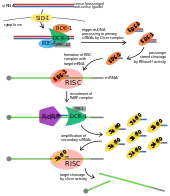RDE-1 (RNAi-DEfective 1) is a primary Argonaute protein required for RNA-mediated interference (RNAi) in Caenorhabditis elegans. The rde-1 gene locus was first characterized in C. elegans mutants resistant to RNAi, and is a member of a highly conserved Piwi gene family that includes plant, Drosophila, and vertebrate homologs.[1]
Role in RNAi pathway

Primary siRNA-argonaute complex
Upon uptake into the cell, exogenous trigger dsRNA is bound by RDE-4 and cleaved into 21-25nt primary siRNA by a Dicer complex that includes RDE-1.[2] Primary siRNA binding to RDE-1 then promotes the formation of the RNA-induced silencing complex (RISC). Unlike in other Argonautes characterized in Drosophila[3] and humans,[4] the catalytic RNase H motif in RDE-1 has not been shown to exhibit Slicer activity of the target transcript. Instead, RNase H activity in RDE-1 is primarily facilitates siRNA maturation through cleavage of the passenger strand.[5]
Secondary siRNA-argonaute complex
The primary Argonaute complex recruits an RNA-dependent RNA polymerase (RdRP) to generate secondary siRNAs, triggering an amplification response. Secondary siRNAs are bound by degenerate secondary Argonautes, which are then directly involved in target transcript degradation.[6] However, RDE-1 shows no stable association with the more abundant secondary siRNAs.[7]
Whereas rde-4 deficiency can be rescued by high concentrations of trigger dsRNA,[8] and secondary Argonaute exhibit functional redundancy,[6] there has been no evidence that RNA-mediated silencing can be reinstated in rde-1 deficient mutants. To this extent, RDE-1 appears to have a qualitatively distinct activity in the exogenous RNAi pathway.[7]
Structure
Canonical Argonaute proteins possess three primary domains forming a crescent-shaped base: the PAZ, MID, and PIWI domains. PAZ and MID orient and anchor the double-stranded siRNA by binding to the 3’ and 5’ termini, respectively, leaving the internal nucleotides accessible for base pairing. The PIWI domain folds into an RNase H-like structure, and contains the conserved catalytic triad “DDH” (two aspartate residues, one histidine residue).[9] The crystal structure of RDE-1 has not been formally elucidated, but can be assumed to closely resemble its human homologs.
Passenger strand degradation
Mutation of any residues in the RNase H catalytic triad abolishes Slicer activity in human Argonaute protein Ago2, suggesting that the RNase H domain is directly responsible for target mRNA degradation.[10] However, RDE-1 has not been implicated in mRNA-cleavage activity.
Instead, RDE-1 with mutations in the conserved DDH motif exhibit reduced passenger (sense) strand turnover, suggesting that RNase H activity serves to cleave the passenger strand, leaving the guide (antisense) strand accessible for base-pairing to target mRNA.[5] Further, target silencing can be fully restored in DDH motif mutants by loading single-stranded siRNA, suggesting that a downstream component in the RNAi pathway is responsible for Slicer activity.[5] Thus, RDE-1's RNase H domain facilitates siRNA maturation but is not directly involved in cleaving target mRNA transcripts.
See also
References
- ↑ Tabara, H.; Sarkissian, M.; Kelly, W. G.; Fleenor, J.; Grishok, A.; Timmons, L.; Fire, A.; & Mello, C. C. (Oct 1999). "The rde-1 gene, RNA interference and transposon silencing in C. elegans". Cell. 99 (2): 123–32. doi:10.1016/S0092-8674(00)81644-X. PMID 10535731.
- ↑ Tabara, H.; Yigit, E.; Siomi, H.; Mello, C.; Mello, C. C. (Jun 2002). "The dsRNA binding protein RDE-4 interacts with RDE-1, DCR-1 and a DExH-box helicase to direct RNAi in C. elegans". Cell. 109 (7): 861–871. doi:10.1016/S0092-8674(02)00793-6. PMID 12110183.
- ↑ Hammond SM, Bernstein E, Beach D, Hannon GJ (Mar 2000). "An RNA-directed nuclease mediates post-transcriptional gene silencing in Drosophila cells". Nature. 404 (6775): 293–296. doi:10.1038/35005107. PMID 10749213. S2CID 9091863.
- ↑ Meister G, Landthaler M, Patkaniowska A, Dorsett Y, Teng G, Tuschl T (Jul 2004). "Human Argonaute2 mediates RNA cleavage targeted by miRNAs and siRNAs". Mol Cell. 15 (2): 185–197. doi:10.1016/j.molcel.2004.07.007. PMID 15260970.
- 1 2 3 Steiner, F. A.; Okihara, K. L.; Hoogstrate, S. W.; Sijen, T.; Ketting, R. F. (Feb 2009). "RDE-1 slicer activity is required only for passenger-strand cleavage during RNAi in Caenorhabditis elegans". Nat Struct Mol Biol. 16 (2): 207–11. doi:10.1038/nsmb.1541. PMID 19151723. S2CID 22909313.
- 1 2 Boisvert, M.E.; Simard, M.J (2008). "RNAi pathway in C. elegans: the argonautes and collaborators". Curr. Top. Microbiol. Immunol. Current Topics in Microbiology and Immunology. 320: 21–36. doi:10.1007/978-3-540-75157-1_2. ISBN 978-3-540-75156-4. PMID 18268838.
- 1 2 Yigit E, Batista PJ, Bei Y, Pang KM, Chen CC, Tolia NH, Joshua-Tor L, Mitani S, Simard MJ, Mello CC (2006). "Analysis of the C. elegans Argonaute Family Reveals that Distinct Argonautes Act Sequentially during RNAi". Cell. 127 (4): 747–57. doi:10.1016/j.cell.2006.09.033. PMID 17110334.
- ↑ Habig JW, Aruscavage PJ, Bass BL (2008). "In C. elegans, high levels of dsRNA allow RNAi in the absence of RDE-4". PLOS ONE. 3 (12): e4052. doi:10.1371/journal.pone.0004052. PMC 2603325. PMID 19112503.
- ↑ Song, J.J.; Smith, S.K.; Hannon, G.J.; Joshua-Tor, L. (Sep 2004). "Crystal structure of Argonaute and its implications for RISC slicer activity". Science. 305 (5689): 1434–7. doi:10.1126/science.1102514. PMID 15284453. S2CID 38557910.
- ↑ Liu J, Carmell MA, Rivas FV, Marsden CG, Thomson JM, Song JJ, Hammond SM, Joshua-Tor L, Hannon GJ (Sep 2004). "Argonaute2 is the catalytic engine of mammalian RNAi". Science. 305 (5689): 1437–41. doi:10.1126/science.1102513. PMID 15284456. S2CID 2778088.
External links
- WormBase entry for rde-1 gene Catalogs alleles, polymorphisms, and C. elegans strains associated with rde-1 gene locus. Full coding transcript available.